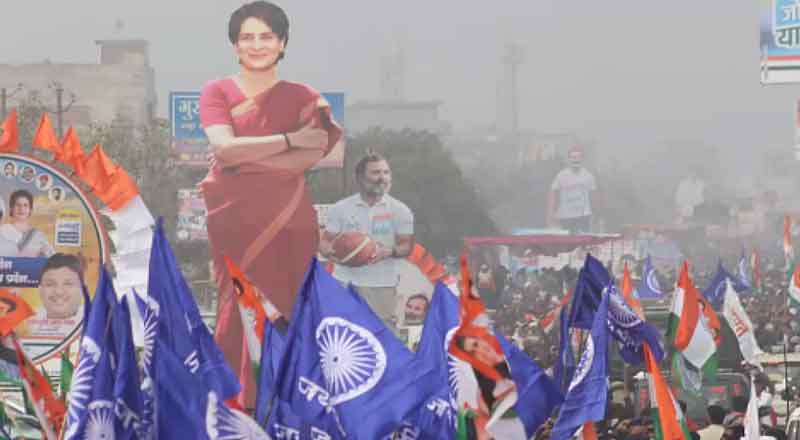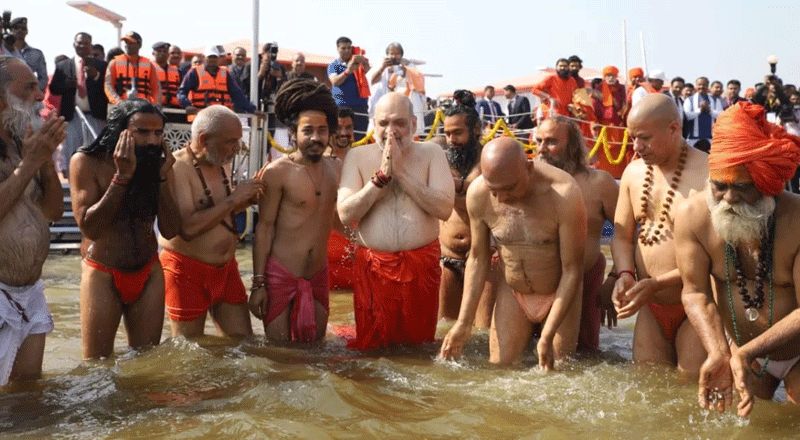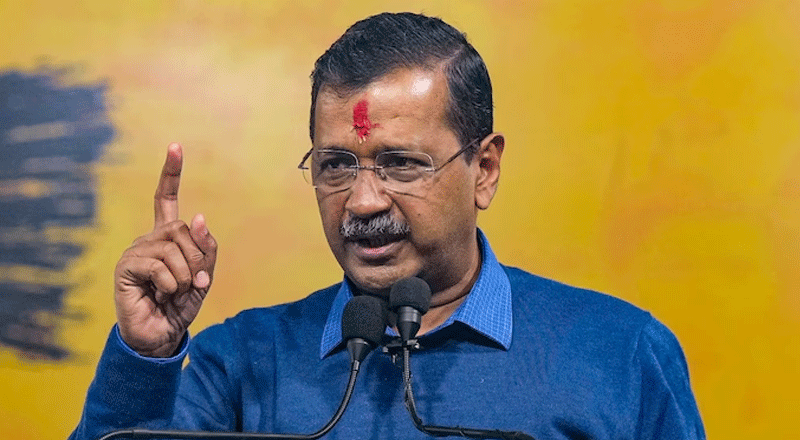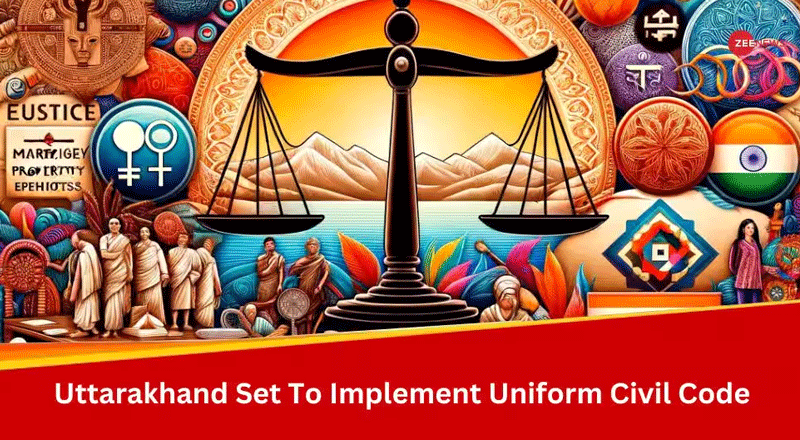The road to Delhi passes through Uttar Pradesh and West UP often stands as a gatekeeper in that journey. While the politics in the regions of Purvanchal in the east, Awadh in central UP, and Bundelkhand in the south is primarily caste-based, the picture is much more complex in West UP where the blend of caste, religion, and farm politics challenges conventional wisdom.
Around two years ago, Western Uttar Pradesh was one of the two bases of the yearlong agitation against the Narendra Modi government’s three now-repealed farm laws — with the other base being Punjab. The agitation was the biggest popular challenge the Bharatiya Janata Party (BJP) faced since 2014 and eclipsed the 2019-20 protests against the Citizenship Amendment Act (CAA) and the proposed National Register of Citizens (NRC). But, in the two years since then, the BJP has won polls in UP and has largely retained its sway in West UP.
Now, the BJP is counting on the ‘Modi factor’, the lack of a ‘face’ of the Opposition, the inauguration of the Ram Mandir, and the fulfilment of other ideological commitments like the abrogation of Article 370 to seek a third straight term. The Congress party hopes its ‘UP Jodo Yatra’ and ‘Bharat Jodo Nyay Yatra’ will revive the party and boost the INDIA coalition’s chances against the BJP in the region. Uniting all of these opposing political forces is their outreach to the region’s influential Jat community.
While traditionally a stronghold of the Rashtriya Lok Dal (RLD), the Jats have drifted to the BJP in recent years and have continued to vote for the party despite leading the charge in the farm protests. While such a reality puzzles many, Bijnor-based Jat leader Digambar Singh says Jats don’t vote as a bloc and that explains their participation in protests and simultaneous vote for the BJP.
“There are sections of Jats aligned with the BJP as well as the RLD. The Jats don’t vote as a collective as there is no one Jat leader. There is no Chaudhary Charan Singh or Mahender Singh Tikait anymore to lead the community and become its face. Jats vote depending upon their personal preferences and calculations on which party better suits their interests,” says Singh, Youth State President of Bharatiya Kisan Union-Apolitical (BKU-A).
What Explains All-Round Outreach To Jats?
In the run-up to the 2024 general elections, leaders across party lines in Uttar Pradesh are invoking the legacy of the tallest Jat leader, Chaudhary Charan Singh, a former Prime Minister and UP Chief Minister.
CM Yogi Adityanath has unveiled a 51-ft statue of Charan Singh and has invoked other historic Jat figures from the mediaeval era, Samajwadi Party (SP) chief Akhilesh Yadav has paid tributes to Charan Singh, the Congress dedicated a day of its ‘UP Jodo Yatra’ to the late Jat leader, and the Rashtriya Lok Dal (RLD) —party run by by Charan Singh’s grandson Jayant Singh— has asked the Centre to honour him with the Bharat Ratna.
The parties have gone to such lengths to claim the votes of a community that numbers less than 2 per cent of the state’s population. But the election is not mere mathematics. The Jats are a historically agrarian community that holds its land and customs close to its heart. This is central to their political relevance. Historian Amit Pathak tells Outlook that the Jats have been highly organised socially and politically since the pre-Independence era and that explains their current sociopolitical relevance.
“Jats have been a political force since the mediaeval era. Since the Sultanate and Mughal periods, Jats had a very strong social organisation centred around ‘khaps’, which were a blend of rural social bodies in charge of customs and local governments running rural affairs. While the imperial rulers governed the cities, the khaps ran the rural North India with minimal imperial interference. Such a system continued till the British advent when they began taking land from the Jat farmers. That’s why Jats rose against the British in the Revolt of 1857 in West UP,” says Pathak, author of ‘History and Culture of Western Uttar Pradesh’ and other books on the region.
By the time of Independence, the Jat consciousness emerged such that it was fundamentally tied to the rights over their land and customs. The Jats resisted any interference with their community affairs. Such consciousness rooted in a history of resistance to ‘central’ powers has guided the Jat polity in Independent India.
“During 1850-1900, with the advent of the Arya Samaj movement, a lot of schools and colleges emerged in rural Western Uttar Pradesh — many of whom even exist today. That marked the educational rise of the Jats which led to social emancipation. Then, in the post-World War I period, the Jats began getting educated in the region and got deeply embedded in the freedom movement. This is how the Jats became a highly sociopolitically organised and influential community by the time of Independence,” says Pathak.
It was during this time that the farmer movements acquired a political dimension as well. Pathak notes that the ‘Gandhi caps’ that the vast majority of Jat leaders wear today are rooted in the adoption of the cap by the community during the independence movement as a mark of support to Mahatma Gandhi.
It was this historic consciousness of the Jats that brought them to the fore of the anti-farm laws protests. The perceived interference of the ‘central’ powers in their way of life —their land and feudal agricultural trading networks— triggered them like the British once did. Even though there is no Mahender Singh Tikait or Chaudhary Charan Singh anymore, the Jats remain a sociopolitical force that no party wants to go against — the BJP has drawn its lessons.
The Divided Jat Polity
Today, however, the Jat polity stands divided with no community leader. The representation of the Jats remains divided between the RLD of Jayant Singh in the Baghpat belt of West UP and the Tikait brothers in the Meerut-Muzaffarnagar belt. Both of them have failed to capitalise on it politically as Jayant and his late father Ajit Singh lost their seats in 2014 and 2019 and the farm movement helmed by Tikait did not leave a major dent in BJP’s performance in the region in the 2022 assembly elections.
BKU-A leader Digambar Singh tells Outlook that the Jat polity is affected by divisions between the RLD’s Singh family and the Tikait families. He further says that a section of the community also has a sense that it did not achieve much by the yearlong protests, so it questions the feasibility of another round of protests.
“West UP was at the core of farm protests. It affected seats in the region in the 2022 elections, but could not do much. We lost more than 700 farmers in the protests, but did we get much out of it? We could not get the MSP [minimum support price]. If we could have got the laws amended instead of repealed, we could have perhaps got more benefits. For these reasons, another round of mass mobilisation are not certain,” says Singh.
As for the Jats’ voting patterns, Singh says that a section of the community —around 40 per cent in his analysis— votes for the BJP for reasons like personal preference and law and order and another 20 per cent goes with the flow and the rest are with RLD or are undecided.
“While the BJP has not been able to do much on corruption in the state despite trying, it has managed to improve the law and order situation. For rural families, particularly whose women have to go out, better law and order is a big factor. A person may overlook low prices for crops if there is a sense of safety,” says Singh.
Sanjeev Kumar Sharma, a longtime observer of UP’s politics, says that among the traditional Jat leaders, only Jayant may make some impact in the region.
“Out of the traditional Jat leaders, only Jayant Singh of RLD may make some impact among the Jats and that too in a limited way and only in the name of his grandfather Chaudhary Charan Singh. The Tikaits do not have the political pull even if they have a degree of social influence,” says Sharma, Professor and Head, Department of Political Science, Chaudhary Charan Singh (CCS) University, Meerut.
Congress Pins Hopes On UP Jodo Yatra
While the central leadership of Congress was planning party leader Rahul Gandhi’s east-to-west ‘Bharat Jodo Nyay Yatra’, the Uttar Pradesh unit of the party was carrying out its own ‘UP Jodo Yatra’ to revive the party organisation in the state.
The UP Jodo Yatra along the lines of the Kanyakumari-to-Kashmir Bharat Jodo Yatra of Rahul is part of the party’s plan to energise the party cadre ahead of the 2024 elections and reach out to the public.
The first leg of the UP Jodo Yatra began from Saharanpur on December 20 and concluded at Lucknow on January 6. Meerut Congress unit chief Avnish Kajla says that the purpose of the yatra was to go out among the people and raise their issues.
“We went among the people to raise the issues of youth, women, and farmers that concern them. There is an atmosphere of hatred. Instead of the elections in the name of religion that the BJP wants, we want to contest elections on the basis of issues. The BJP does not want these issues to come up,” says Kajla.
Kajla says the schedule of the second leg of the UP Jodo Yatra is not yet finalised and will be decided by the state leadership and Avinash Pande, the party in-charge for the state. As for the West UP, he says the region’s farmers will rise up against the BJP.
“Every farm movement has risen from Western Uttar Pradesh. The farmers of the region will rise again against Narendra Modi in the 2024 elections. The BJP wants to avoid contesting elections on issues and instead focus on religion, but I believe that people will vote on the basis of issues. You may interpret our yatra in any way since elections are coming, but our purpose was to go among the people, raise the issues of agriculture, unemployment, and crime, and make this an election based on real issues,” says Kajla.
Political observer Sanjeev Kumar Sharma says the UP Jodo Yatra may only have a very limited effect on the elections in the region, but adds that the coming together of non-BJP parties in the INDIA coalition can make an impact. But that too has a key caveat.
“The Bahujan Samaj Party (BSP) is not part of the INDIA bloc. The BSP has largely retained its core voter bloc over the years even if it has not won many seats recently. The absence of BSP means that the Samajwadi Party (SP) is the only large party against the BJP with Congress and RLD in supporting roles,” says Sharma.
The BJP is also dismissive of the UP Jodo Yatra and instead is turning the focus to the Ram Mandir inauguration. Suresh Jain ‘Rituraj’, the chief of BJP’s Meerut City unit, says the coming together of INDIA bloc has “unmasked the parties as complete opportunists”.
“Narendra Modi promised Ram Mandir and he delivered. He also delivered on the promise to abrogate Article 370. That’s what we have. On the other hand, there is infighting in the Opposition and the building of Ram Mandir and abrogation of Article 370 were impossible under them,” says Rituraj.
As for the consolidation of non-BJP voters that the INDIA bloc is seeking, and the effect of yearlong farm agitation in Meerut and surrounding West UP region, Rituraj says there will obviously be some impact but it will not affect the bigger picture. In the 2019 general elections, the BJP won the Meerut-Hapur constituency by a narrow margin of around 4,700 votes.
“In 2019, the BSP and SP were together. That alliance is no longer there. There will of course be some effect of the consolidation attempts, but the Opposition does not have a face. There will not be much effect,” says Rituraj.
How INDIA Stands Against BJP In Ram Mandir’s Shadow?
With its stand on the Ram Mandir inauguration, Congress appears to have taken several steps back at a time when the state unit of the party was taking steps towards rebuilding the party ahead of the national elections.
The Congress central leadership has boycotted the Ram Mandir inauguration and has termed it an “RSS-BJP event”. No leading Opposition party has taken such a sharp position. Akhilesh Yadav of SP, Sharad Pawar of NCP, and Arvind Kejriwal of AAP, among others, have all given much more measured statements.
The Congress party is now alienated not just from the popular sentiment, but also from the fellow parties of the INDIA bloc, says political observer Sanjeev Kumar Sharma.
Bijnor-based farmer leader Digambar Singh highlights that even though a person may not vote for the BJP, they may still believe in the Ram Temple and may be swayed by the inauguration.
Religious beliefs go beyond party lines and one may believe in Ram and may look forward to the Ram Mandir even though they may vote for a party other than the BJP, says Sharma of CCS University’s Department of Political Science.
“In such a case, the Congress is only getting alienated by having such a sharp aversion to the Ram Mandir inauguration. The state unit is trying to control the damage but the central leadership has already created a perception that it is against the temple and that cannot be changed now. Politics is all about perception,” says Sharma.
Sharma further says that the BJP has presented the Ram Mandir inauguration as a ‘jan utsav’ and it has the potential of triggering an undercurrent in its favour ahead of the polls that may negate at least some of the consolidation the INDIA bloc is seeking.
The INDIA coalition has another challenge and it goes beyond UP. The coming together of leaders is not enough to transfer the voters of one party to the candidate of its newfound ally. This was seen in UP in 2019 when SP and BSP came together but their voters did not converge. The lingering historical sociopolitical bitterness among the cadres and voters was the reason.
“The en bloc transfer of votes happens when something huge happens. This was the case in West Bengal when Mamata Banerjee stormed to power and voters rallied behind her to end the decades-long rule of the Left. The mass movements before the 2014 elections also created somewhat similar conditions. But, even with all the issues, the BJP does not yet face such Bengal- or 2014-like opposition. Hence, the en bloc transfer of votes is not certain,” says Sharma.
Now, ahead of the elections, the Congress party appears to have miscalculated again on the issue of Ram Mandir. Ironically, the decline of the party in the state began with another similar miscalculation – the opening of the locks at the site during Rajiv Gandhi’s tenure as Prime Minister. In his book ‘From Lucknow to Lutyens: The Power and Plight of Uttar Pradesh’, Abhigyan Prakash notes that while the Congress leaders maintain Rajiv had to respond to the caste and religious politics of the time and do something, “they tend to forget that the tactic of polarisation in the state was actually introduced by the SP, BSP and BJP to counter Congress dominance in the state”.





